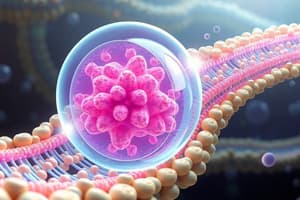Podcast
Questions and Answers
What best describes diffusion?
What best describes diffusion?
- The random spreading of particles resulting in net movement from high to low concentration. (correct)
- The movement of particles from low to high concentration.
- The transfer of particles through a solid barrier.
- A process requiring energy input for particle movement.
Which of the following substances can diffuse across a cell membrane?
Which of the following substances can diffuse across a cell membrane?
- Starch
- Carbon dioxide (correct)
- Oxygen (correct)
- Urea
What is the role of temperature in the process of diffusion?
What is the role of temperature in the process of diffusion?
- Temperature has no effect on diffusion processes.
- Higher temperatures increase kinetic energy and speed of diffusion. (correct)
- Higher temperatures decrease kinetic energy.
- Lower temperatures increase particle movement.
What characteristic of the cell membrane allows for selective substance diffusion?
What characteristic of the cell membrane allows for selective substance diffusion?
In the context of cellular respiration, which substance must diffuse into cells?
In the context of cellular respiration, which substance must diffuse into cells?
Which statement about the diffusion process is true?
Which statement about the diffusion process is true?
What is the driving force behind the diffusion of substances into and out of cells?
What is the driving force behind the diffusion of substances into and out of cells?
During which process do liver cells excrete the waste product urea?
During which process do liver cells excrete the waste product urea?
Flashcards
Diffusion
Diffusion
The spreading out of particles from an area of high concentration to an area of low concentration.
Concentration Gradient
Concentration Gradient
Difference in concentration of a substance between two areas.
Cell Membrane
Cell Membrane
A barrier surrounding a cell that controls what enters and exits.
Partially Permeable Membrane
Partially Permeable Membrane
Signup and view all the flashcards
Oxygen diffusion
Oxygen diffusion
Signup and view all the flashcards
Carbon dioxide diffusion
Carbon dioxide diffusion
Signup and view all the flashcards
Passive transport
Passive transport
Signup and view all the flashcards
Substance exchange
Substance exchange
Signup and view all the flashcards
Study Notes
Diffusion
- Definition: Diffusion is the spreading out of particles (in a solution or gas) from an area of higher concentration to an area of lower concentration, driven by random particle movement. Particles move net from high to low concentration.
- Mechanism: Particles are constantly moving randomly. Higher concentration = more particles = more movement from that area, and vice versa.
- Passive Process: Diffusion is passive, relying on the kinetic energy of particles. Higher temperatures mean faster particle movement, thus faster diffusion.
- Cell Membranes: Cell membranes are partially permeable; some substances can pass through them by diffusion, others cannot.
- Examples of diffusion in organisms:
- Oxygen diffuses into cells for respiration.
- Carbon dioxide diffuses into plant cells for photosynthesis.
- Urea (waste product) diffuses out of liver cells.
- Carbon dioxide diffuses out of cells.
- Concentration Gradients: Diffusion is driven by the concentration gradient between the cell and its environment. If the gradient changes so will the direction of diffusion.
Studying That Suits You
Use AI to generate personalized quizzes and flashcards to suit your learning preferences.





